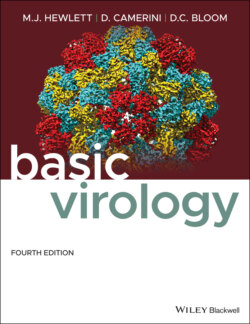Читать книгу Basic Virology - Martinez J. Hewlett - Страница 42
Some viruses with human reservoirs
ОглавлениеA significant number of human viruses leading to either mild or life‐threatening disease are maintained solely in human populations. The list runs the gamut from colds caused mainly by rhinoviruses, warts caused by papillomaviruses, to AIDS caused by HIV. The mode of passage of viruses between humans (i.e., the vector) is intimately linked to human behavior. This behavior can be modified by the disease symptoms themselves. Thus, a respiratory infection leads to irritation of the airways resulting in coughing and sneezing, which spreads an aerosol of droplets containing virus. Herpes simplex virus 1 (HSV‐1) is spread in saliva resulting in transfer of the virus to the recipient's oral epithelial cells; in contrast, the closely related varicella zoster virus (VZV, or chickenpox) is spread by inhalation of a virus‐loaded aerosol or dust containing dead skin flakes. Warts are spread by direct physical contact between the virus‐loaded source (another wart or dead skin from a wart) and layers of the skin below the keratinized epidermis exposed by small cuts or abrasions. Poliovirus and the related coxsackieviruses are spread by virus‐containing feces contaminating food, drinks, or fomites that are ingested; this is termed oral‐fecal spread. In the case of HIV, body fluids – including blood, breast milk, serum, vaginal secretions, and seminal fluid – are sources of infection. The virus can be spread by passive inoculation of, for example, a contaminated hypodermic syringe, or by transfusion, breastfeeding, or sexual activity.
Table 3.1 Some pathogenic viruses, their vectors or routes of spread, and their hosts.
| Virus | Vector/Route | Host | Disease |
|---|---|---|---|
| Poliovirus | Human–fecal contamination of water or food | Human | Enteric infection; in rare cases, CNS infection (poliomyelitis) |
| Western equine encephalitis | Mosquito | Horse | Viral encephalitis in the horse – occasional infection of human |
| La Crosse encephalitis | Mosquito | Squirrel, fox (reservoir); human | No obvious disease in squirrel or fox; viral encephalitis in human |
| Sin Nombre virus (hantavirus) | Deer mouse | Deer mouse, other rodents (reservoir); human | Hantavirus hemorrhagic respiratory distress syndrome |
| HIV | Direct injection of virus‐infected body fluids into blood | Human | AIDS |
| Measles | Aerosol | Human | Skin rash, neurological involvement |
| Yellow fever | Mosquito | Tropical monkeys; human | Malaise, jaundice |
| Chikungunya | Mosquito | Human, primates | Mild to severe hemorrhagic and arthritic disease |
| Dengue fever | Mosquito | Human, primates | Mild to severe hemorrhagic disease |
| Ebola | Unknown vector, but nosocomial transmission | Fruit bat; humans and primates | Often fatal hemorrhagic fever |
| Hepatitis A | Fecal contamination of water or food | Human | Acute hepatitis |
| Hepatitis B | Direct injection of blood | Human | Chronic hepatitis, liver carcinoma |
| Hepatitis C | Direct injection of blood | Human | Acute and chronic hepatitis |
| Hepatitis delta | Blood, requires coinfection with hepatitis B | Human | Acute hepatitis |
| Hepatitis E | Fecal contamination of water or food | Human | Mild acute hepatitis, except often fatal to pregnant women |
| Norovirus | Fecal contamination of water or food | Human | Severe diarrhea |
| Rabies | Bite of infected animal | Vertebrates | Fatal encephalitis |
| Herpes simplex virus (HSV) | Saliva, other secretions | Human | Surface lesions followed by latency, rare encephalitis |
| Varicella zoster (VZV, or chickenpox) | Aerosol, infected skin cells (dander) | Human | Rash, shingles, latency |
| Epstein–Barr virus (EBV) | Saliva | Human | Infectious mononucleosis, latency |
| Influenza | Aerosol | Human, many vertebrates | Flu |
| Myxoma | Insect bite | Rabbits | Variable mortality, skin lesions |
| Rhinovirus | Aerosol | Human | Colds |
| Coronavirus (CoV) | Aerosol | Civet cat (SARS‐CoV); camel (MERS‐CoV); human | Colds, SARS, MERS, COVID‐19 |
| Rubella (German measles) | Aerosol | Human | Mild rash, severe neurological involvement in first‐trimester fetus |
| Adenovirus | Aerosol, saliva | Human | Mild respiratory disease |
| Papillomavirus | Contact | Human | Benign warts, some venereally transmitted, some correlated with cervical carcinomas |
| HTLV (human T‐cell leukemia virus) | Injection of blood | Human | Leukemia |
| Tomato spotted wilt (bunyavirus) | Thrip | Broad range of plant species | Necrosis of plant tissue, destruction of crops |
| Cadang‐cadang (viroid) | Physical transmission via pruning | Coconut palm | Coconut palm pathology |
| Prion (protein pathogen) | Ingestion or inoculation of prion protein | Human, other mammals have specific types, cross‐species spread possible | Non‐inflammatory encephalopathy |
| Plant rhabdoviruses | Leaf hoppers, aphids, plant hoppers | Broad range of plant species | Necrosis of plant tissue, destruction of crops |
| Zika virus | Mosquito | Human, primates | Mild to severe disease, microencephaly, Guillain–Barré syndrome |
